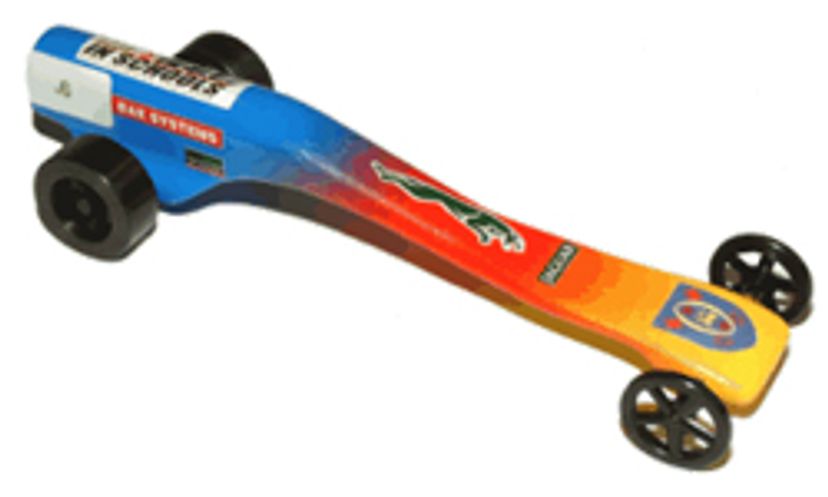
Because it's so similar to the Pinewood Derby, where small wooden cars are raced on a downhill track, CO2 dragster racing is called the "Pinewood Derby on steroids." That's because the cars are similar, but CO2 Dragsters use propulsion instead of gravity to race.
That's an easy one! CO2 dragsters are propelled by the release of carbon dioxide, or CO2 gas, from a pressurized cylinder.
CO2 racers pack a lot of power for their size. They can easily move at highway speeds or greater.
Advertisement
Usually the kits include wheels, axles, a block of wood and a CO2 cartridge for propulsion. It's a blank slate that you must modify into a racer.
The great thing about CO2 dragsters is their incredible potential for customization. They can be made to look like anything you want, but those shapes may not always have the best racing properties.
Mass, or how large and heavy the car is, is the most important factor when it comes to design. Simply put, the less weight your dragster has, the faster it will go.
Advertisement
The best way to test for drag is to put the car into a wind tunnel, where air flows over the car's body and indicates how smooth the flow will be. You want the airflow to be as smooth as possible.
The CO2 cartridge, which propels the racer down the track, is also known as a "soda bulb."
The gas escaping from the back of the car pushes it forward with a force called thrust. It's one example of the many physical forces at work when racing a CO2 dragster.
Advertisement
Drag is the force of the air pushing against the car's body, creating resistance and making it move slower than it could in a vacuum.
In terms of physics, the rapidly escaping gas causes Newton's Third Law of Motion to occur -- for every action there is an equal or opposite reaction. The rearward motion of the gas pushes the car forward in this case, overcoming inertia, or the resistance to movement.
The lightest and most aerodynamic car will win because the amount of thrust is the same on all cars. Think of it as a drag race between two cars with the same engine but different bodies.
Advertisement
Friction is the second most important force you'll face. Because the dragster has parts moving against one another, friction is created.
Because the dragster has parts moving against one another, friction is created. You can help reduce it by making sure the axles are free to rotate, and that the wheels and tires are not rubbing on the car body.
Once the cars are ready to race, the sealed cartridge is inserted, and they are placed on the starting grid. Often, they're hooked up to a device called a launch pod, which punctures the cartridges of two or more cars at the same time. These devices can also be built by hand using some wood and nails to puncture the CO2 canisters.
Advertisement
Building a CO2 dragster can be a great project at schools because it teaches students about aerodynamics, as well as things like friction, inertia and mass. It can also be done as a competitive event or hobby.
Drag racing! It makes sense that a car called a dragster would race in drag racing, right? In that type of racing, two or more cars see which one can travel the fastest in a straight line.
By putting your car into the wind tunnel and putting a fog vapor into the air stream, you can track how air flows over the car's body. You want a smooth flow of air free of swirling currents called eddies. If you have too many of those, you may want to use sandpaper to smooth out the design, or go with a new one altogether.
Advertisement
It's hard to tell with the naked eye just how much drag your CO2 car will face. For that reason, you may want to opt for a wind tunnel. Believe it or not, there are small wind tunnels available designed to test models.
On many dragster kits, the hole for the cartridge comes already drilled, and when sculpting the wood the designer simply works around it. On other kits, the hole must be drilled out manually.